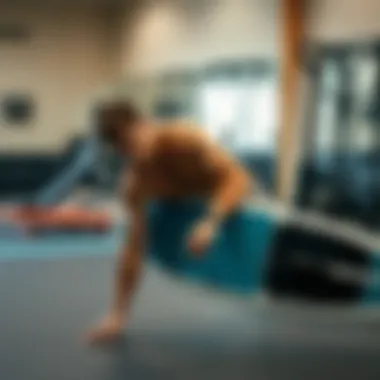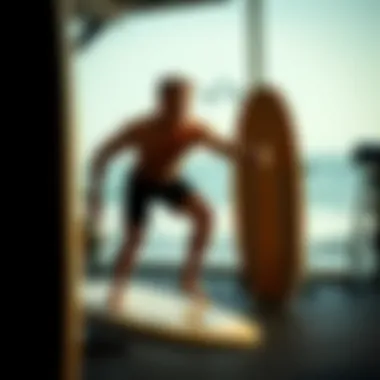Essential Gym Exercises for Surfers' Fitness


Intro
In the realm of water sports, surfing stands out as a true test of both physical prowess and mental resilience. The dynamic nature of the ocean demands that surfers not only possess skill but also the physical abilities to perform at their best. Optimizing one’s fitness for surfing is not just about hitting the waves with enthusiasm; it requires a structured approach to training that encompasses strength, flexibility, and endurance.
This article aims to explore the fundamental gym exercises tailored specifically for surfers. We will dissect the unique physical demands surfing imposes—such as balance, core stability, and agility—and identify exercises that can help build these essential attributes.
By connecting gym workouts to surfing efficiency, enthusiasts can gain a clearer picture of how to refine their fitness regimens for optimal performance in the surf. Always remember, a well-rounded training routine not only prepares one for riding the waves but can also enhance the overall experience of being in tune with the ocean.
Intro to Surfing Fitness
Surfing is more than just a leisure activity; it’s a full-body workout requiring agility, balance, endurance, and strength. When you’re out on the water, your body is constantly engaged—paddling, popping up, maintaining balance, and maneuvering through waves. With these unique demands in mind, optimizing fitness for surfing becomes essential for improving performance and reducing the risk of injury.
Understanding the Unique Demands of Surfing
Each surf session involves distinct physical challenges. Surfers must maintain their balance on a board while navigating unpredictable ocean conditions. Core strength plays a pivotal role, as it helps in stabilizing the body during quick movements on the waves. Additionally, the constant paddling requires upper body strength and endurance, while the ability to generate speed while standing calls for powerful leg muscles. Therefore, recognizing these unique demands is the first step toward developing a targeted fitness regime that enhances surfing skills.
The Importance of Physical Conditioning
Physical conditioning isn’t just a box to tick; it is the backbone of a surfer's ability to perform. Neglecting this aspect can lead to untimely fatigue, poor performance, or even injury. Surfing relies heavily on a combination of strength, flexibility, and endurance. Conditioning prepares your body to handle the strain of surfing by improving muscle performance and enhancing recovery times. With proper conditioning, surfers can take on difficult waves without as much wear and tear on their bodies, allowing for longer, more enjoyable sessions in the water.
"A fit surfer is not only about looking good; it’s about having the stamina to keep going when others are giving up."
Core Stability and Its Role in Surfing
Core stability is the backbone of effective surfing. Understanding this fundamental concept allows surfers to enhance their performance significantly. The waves are unpredictable and their forces can be immense; it’s essential for a surfer to have a strong core to maintain balance and control.
A well-developed core doesn’t merely support the torso; it stabilizes the whole body. As surfers ride waves, they are continually shifting their weight. Whether turning, paddling, or popping up, the body relies heavily on the engagement and strength of core muscles. Therefore, a robust core leads to better maneuverability on the board, improved power transfer when paddling, and decreased likelihood of injury.
Moreover, surfers with solid core stability can manage to hold their positions on the board more effectively as they’re constantly dealt with the dynamic forces of the ocean. This advantage is crucial not just for performance but also for longevity in the sport. In summary, core stability is a non-negotiable element in enhancing one’s surfing capabilities.
The Mechanics of Core Engagement
Understanding core engagement is akin to grasping the intricacies of a well-tuned engine. The core comprises various muscles—rectus abdominis, obliques, and transversus abdominis, among others. These muscles work in unison, much like an orchestra, to provide stability as one navigates the complexities of surfing. When the core engages, it creates a solid foundation. This foundation is what enables surfers to execute movements more powerfully and precisely.
It’s important to note that core engagement is not simply about tightening the abs; it's more about activating all surrounding muscles to work harmoniously. It’s akin to finding that sweet spot on a surfboard that offers the best control. Engaging the core correctly will lead to a more balanced surfing stance and better reactions to unexpected changes in wave dynamics. A deep understanding of how to effectively engage the core can make the difference between falling off the board and riding the wave with grace.
Key Core Exercises for Surfers
Planks
Planks are a staple in any core workout routine, and there’s a good reason for that. They are simple yet effective, allowing just about anyone to engage various core muscles without the need for equipment. Skimming the surface of a plank, you’ll find that it emphasizes not just the abdominal muscles but also the shoulders, back, and legs. This comprehensive engagement is crucial for surfing.
The beauty of planks lies in their adaptability; they can be modified for all levels. This makes it easy for a surfer to progressively challenge themselves. A unique feature of planks is that they promote isometric strength, which is holding a position rather than dynamic movements. This is beneficial in helping surfers maintain stability when faced with the jarring forces of waves. However, it is essential to maintain proper form; otherwise, it may lead to lower back strain rather than strengthen the core effectively.
Russian Twists
Russian twists offer a dynamic way to build rotational strength, necessary for sharp turns and quick maneuvers on a board. This exercise focuses on the obliques—the muscles located on the sides of the abdomen—allowing surfers to rotate their upper body while keeping the lower body stable. In surfing, sharp movements often come into play during turns, and a strong core helps to execute these moves efficiently.
A highlight of Russian twists is their capacity to build endurance in core muscles. This endurance is key when riding a wave for an extended period or battling against challenging conditions. However, it should be noted that good form is essential. Improper twisting can lead to strain and diminish the effectiveness of the workout.
Medicine Ball Throws
Medicine ball throws offer a more explosive challenge for surfers looking to enhance power and coordination. This exercise mimics the rotational and lateral movements that are crucial while surfing; as you throw the ball, you engage the core in a functional way that resonates with your time on the waves. This kind of training enriches hand-eye coordination and builds strength in the muscles that matter.
What makes medicine ball throws particularly advantageous is their ability to prep the body for real-world surf conditions. They help translate gym strength directly into surfing performance. Still, this dynamic exercise should be approached with caution; proper technique is critical to avoid injury, primarily if it’s done in a controlled setting and not overexert oneself, especially during initial attempts.
Building Strength for Surfing Performance


Building strength is a cornerstone of any fitness regimen geared towards surfing. The unique demands of surfing require a robust fusion of power, endurance, and functional capacity. Surfers face a variety of physical challenges, from paddling out to catching waves and maintaining balance while riding. Each of these components necessitates strength not just in the obvious muscles, but also in often overlooked stabilizing muscles that play critical roles in overall performance.
By cultivating strength, surfers can enhance their control and stability on the board, allowing for more dynamic movements and sharper turns. Importantly, this strength helps in injury prevention—an essential consideration given the often unpredictable nature of surfing environments.
In essence, the strength built in the gym translates directly to performance on the waves, making it imperative that surfers incorporate effective strength training into their workouts. This establishment of strength can lead to better wave management and a more enjoyable surfing experience overall.
Understanding Functional Strength
Functional strength refers to the type of strength that is applicable in real-world situations, particularly in athletic activities. For surfers, this means developing strength that helps with balance, agility, and power during the act of surfing. Instead of simply lifting weights in isolation, functional strength ensures that exercises mimic the movements needed on a surfboard.
For instance, when paddling out to sea, a surfer engages various muscle groups in tandem. The right strength training should reflect this relationship, focusing on compound movements that involve multiple joints and muscle groups working together.
By developing functional strength, surfers can improve their efficiency in the water, allowing them to paddle faster, maneuver with grace, and ultimately maximize their time on the waves.
Effective Strength Training Exercises
Deadlifts
Deadlifts stand out as a prime exercise in building overall strength crucial for surfers. This compound movement not only targets the back and legs but also engages the core, which is vital for maintaining balance while on a surfboard. The key characteristic of deadlifts is that they require coordination and technique, making them a beneficial choice for developing strength that translates directly to surfing.
One unique feature of deadlifts is their ability to increase functional strength, as they involve lifting a weight from a standing position—an action similar to getting up on a surfboard after a wipeout. The advantages include improved power output and enhanced stability. However, it’s important to approach this movement with proper form to avoid injury.
Push-Ups
Push-ups are a staple in bodyweight training and are especially beneficial for surfers. They enhance upper body strength while engaging the core, which is critical for maintaining balance. The primary strength develops through the chest, shoulders, and triceps, but the stabilizers involved significantly contribute to overall surfing performance.
The beauty of push-ups lies in their adaptability; whether performed on sand, grass, or a gym floor, they can be done anywhere. Their unique feature is that they help to maintain shoulder health, which can be compromised during rigorous surfing sessions. The only drawback is that they may not provide enough resistance for advanced surfers looking for greater strength gains but can be easily modified to increase difficulty.
Pull-Ups
Pull-ups are another powerful exercise that significantly aids surfers. They primarily target the upper back, shoulder, and arm muscles, important for paddling strength. The key characteristic of pull-ups is their ability to enhance grip strength, which is essential when catching waves and controlling the board.
Additionally, pull-ups help promote body awareness and control, two critical facets of surfing that allow for quick movements on a wave. While they are highly effective, they can be quite challenging initially; however, they build immense strength over time, providing a strong advantage in the water.
Engaging with Resistance Bands
Resistance bands represent a versatile tool for strength training, particularly valued in surf fitness for their ability to replicate a multitude of movements surfers encounter. By providing variable resistance, they improve muscle activation across different ranges of motion, making them ideal for functional strength training.
Using resistance bands allows surfers to work on specific movements that mimic paddling and balance. For example, doing band rows can build pulling power, while overhead presses can replicate the motions involved in getting up on the board.
It’s worth noting that bands are portable and can be easily integrated into any workout environment, making them accessible for anyone looking to enhance their surfing performance through strength training.
Enhancing Flexibility for Better Movement
Flexibility is not just a fancy term thrown around in yoga classes; it can be a game-changer for surfers aiming to improve their skills on the waves. Surfing places unique physical demands on the body, requiring a wide range of movement and the ability to adapt to constantly shifting conditions. As such, flexibility directly affects how one maneuvers on the surfboard, impacts balance, and even determines recovery times from injuries.
Consider this: a surfer who can achieve greater flexion in the hips and shoulders can pivot and rotate more effectively, which is crucial for maintaining speed while turning. Consequently, enhancing flexibility becomes essential not just for performance but also for injury prevention. Without adequate flexibility, surfers often struggle to maintain proper form, leading to muscle strains and joint issues.
The Role of Flexibility in Surfing Techniques
Flexibility facilitates refined movements, allowing surfers to position themselves dynamically on the board. Greater flexibility in the legs and core enables smooth transitions from paddling to popping up, while enhanced shoulder and thoracic mobility can make a significant difference when executing tricks or navigating the waves effectively.
Furthermore, if a surfer possesses flexibility, it positively impacts their balance. With better range of motion, they can maintain stability during their ride, yielding more engaging and controlled performances. Therefore, making flexibility training a key component of one’s fitness regimen can greatly influence how proficient a surfer becomes over time.
Stretching Routines for Surfers
Incorporating stretching routines specifically designed for surfers into a workout can yield impressive results. These routines can be broken down into three distinct categories: dynamic stretching, static stretching, and yoga for surfers.
Dynamic Stretching


Dynamic stretching involves moving parts of your body through their full range of motion. It's not just about warm-ups; this type of stretching gets your muscles ready to work. For surfers, dynamic stretches can mimic the movements experienced during surfing, thus preparing the body for activity. One key characteristic is that it increases blood flow, enhancing muscle elasticity while preparing joints for the task ahead. Surfers who prioritize dynamic stretching tend to find they can perform better right off the bat.
However, it's not without its downsides. Some believe it's less effective in increasing overall flexibility compared to static stretching. But, the unique feature of dynamic stretching is its ability to energize and activate without the danger of muscle tightness.
Static Stretching
On the flip side, static stretching involves holding a stretch for a period, often to the point of mild discomfort. For surfers, static stretches are beneficial post-workout or after a surf session, as they help in lengthening muscles that may have tightened during activity. One of the key characteristics of static stretching is its potential to improve overall flexibility significantly over time. Surfers might find that engaging in a static stretching routine makes it easier to maintain yoga poses or balance techniques.
Challenges arise when static stretches are performed improperly, which could lead to injuries rather than remedying them. Furthermore, static stretching should not replace warm-up routines but rather complements them for optimal flexibility benefits.
Yoga for Surfers
Yoga is often dubbed the secret weapon for surfers, and rightfully so. Yoga for surfers encompasses poses that are particularly geared towards enhancing flexibility and core strength, thus benefiting surfing performance. The graceful flow of yoga helps in lengthening muscles while promoting balance, stability, and breath control. One unique feature of yoga is its holistic approach, addressing both physical and mental aspects of fitness.
As a popular choice in surf culture, it offers a tailored routine that works well for many individuals. Nonetheless, it might require an investment of time and patience to reap its full benefits, which could deter some. However, the advantages far outweigh the drawbacks, especially in improving flexibility, focus, and managing stress.
With each of these stretching methods, surfers can cultivate enhanced flexibility tailored to their unique needs and preferences, ultimately leading to better performance while also protecting themselves from potential injuries in the water.
Developing Endurance for Extended Sessions
Building endurance is vital for surfers looking to make the most of their time in the water. Unlike a quick dash to the shore, surfing often calls for long periods of paddling and waiting for the perfect wave. Developing the stamina to endure these sessions can mean the difference between struggling to stay in the game and riding waves with ease. Moreover, having a higher level of endurance enables a surfer to recover faster between efforts, reducing fatigue and allowing for a more enjoyable experience on the waves.
Why Endurance Matters in Surfing
Endurance in surfing does not just relate to physical capability; it influences almost every aspect of the activity. From paddling out to catching waves and holding balance while riding, it’s essential to have robust cardiovascular fitness. The ocean can be unpredictable, and surfers might find themselves navigating against currents or dealing with long waits between sets. With higher endurance, surfers can handle these challenges without experiencing early fatigue.
"Endurance isn't just about resisting tiredness; it's about finding joy in every ride, no matter how long you’re out there."
This resilience means catching more waves over a longer session, ultimately enhancing the overall experience. Being in shape for stamina also helps maintain focus, decision-making, and safety while out in the water.
Cardiovascular Workouts for Surfers
Cardiovascular exercises are paramount for building the endurance needed for surfing. Here’s a breakdown of some effective workouts:
Running
Running is one of the simplest and most accessible forms of cardio. It offers a terrific way to build endurance and aerobic fitness, vital for surfers who need to paddle efficiently for extended periods. The beauty of running lies in its versatility: it can be done almost anywhere and at any time. By establishing a regular running routine, surfers can increase lung capacity and overall stamina. However, one must note that the impact on joints can be significant, so it's crucial to incorporate rest days and vary terrains—perhaps mixing pavement with trails.
Cycling
Cycling serves as another accessible endurance-building exercise. Its low-impact nature helps reduce strain on the knees and hips while still providing a rigorous workout. Cyclists can pedal away from the grind of high-impact activities and instead focus on developing leg strength and cardiovascular fitness, both necessary for powerful paddling. One unique feature of cycling is its ability to mimic the aerobic demands of surfing. Surfers often find themselves exerting similar muscle groups, making this an excellent training tool. On the flip side, long-distance cycling might lead to a tightness in hip flexors, so stretching is key after each session.
Swimming
Swimming embodies the very essence of surfing—being in the water while developing incredible endurance. This exercise not only works the same muscle groups but also improves cardiovascular health and lung capacity. Specifically, swimming builds upper body strength through repetitive strokes that mirror paddling. Another highlight is that swimming in different strokes allows surfers to develop muscle balance. This full-body workout, while beneficial, can also be pretty exhausting if one is not accustomed. It’s wise to start slow and gradually increase swimming sessions to avoid overexertion.
For further reading on endurance and its impact on sports performance, check out American Heart Association and Mayo Clinic.
Integrating Balance Training into Regimen
In the intricate dance of surfing, maintaining one's balance is just as essential as paddling out and catching waves. This section dives into the importance of balance training, exploring its core elements, benefits, and why it deserves a crucial spot in every surfer's fitness routine. For surfers, balance is not merely a skill; it is the foundational element that dictates how effectively they navigate the unpredictable waters.
The Connection Between Balance and Surfing
Balance enables surfers to maintain stability atop their boards, allowing for quick adjustments whether they’re riding a gentle swell or navigating the turbulence of stronger waves. The act of surfing is a dynamic interplay of weight distribution and shifting postures, so a good balance helps prevent falls and enhances performance. As one rides a wave, the center of gravity constantly shifts, making balance training a key component in preparing for these fluid movements.
The relationship between surfing and balance training extends beyond just physical prowess; it also fosters mental acuity. Surfers need sharp reflexes and the ability to anticipate what is happening around them. Training that focuses on balance gives surfers a leg up, quite literally.


Exercises to Enhance Balance
- Bosu Ball Exercises
Bosu ball exercises take balance training up a notch. The unique half-sphere design forces engagement of the core and stabilizing muscles, making it a standout option for surfers. When balancing on the Bosu, every little movement challenges muscle activation, which translates directly to maintaining stability on a board. One of the key advantages is the versatility of the Bosu; it can be used for various exercises, from squats to push-ups, all while enhancing balance. However, it can be tricky for beginners, leading to potential falls if not utilized cautiously. - Single-Leg Stands
This exercise urges stability by isolating one leg's strength and coordination. The single-leg stand is simple yet effective, emphasizing the engagement of core muscles and enhancing proprioception—the awareness of one’s body in space. Such engagement is crucial for surfers when adjusting their stance on the board. A major draw of this exercise is its accessibility; it doesn’t require any equipment, making it easy to incorporate into daily routines. However, as straightforward as it sounds, beginners might find it challenging to hold their posture without wavering, thus requiring consistent practice. - Foam Roller Balances
Balancing on a foam roller adds an element of instability that mimics the unpredictability of ocean waves. This exercise helps strengthen the stabilizing muscles while also improving mobility. A foam roller serves dual purposes, acting as both a balance tool and a massage instrument, which can aid recovery as well. The inherent challenge of keeping balance on a rolling surface reinforces those crucial stabilization muscles. However, it may not be the best option for those just starting out, as the difficulty level could lead to falls if one is not accustomed to balance exercises.
Integrating balance training into a surf-based fitness regimen is not just beneficial but necessary for those looking to maximize their potential on the waves. Through dedication to these exercises, surfers can enhance their stability, improve their overall performance, and navigate the swells with more confidence and skill.
Monitoring Progress and Adapting Routines
Monitoring and adapting your workout routine is an integral part of optimizing fitness for surfing. As each individual brings unique strengths, weaknesses and different levels of experience into their training, regular assessment and discourse of progress helps surf enthusiasts fine-tune their approach to fitness. With the ocean being an unpredictable environment, having a robust fitness regimen can directly translate to better performance on the waves.
Firstly, keeping tabs on your progress enables you to identify what works and what doesn’t. With the right plan, you can modify your exercises based on how your body responds, making sure you’re always pushing forward. Not all surfers have the same physical makeup or surfing style, meaning one-size-fits-all strategies often fall flat.
Benefits of Monitoring Progress:
- Personalized Adjustments: Understand when to switch things up or stick with a routine that’s yielding results.
- Injury Prevention: Recognizing your limits helps you dodge potential injuries that could sideline you.
- Increased Motivation: Seeing how far you’ve come can give you a much-needed boost to keep going.
When you commit to tracking your journey, it not only serves as a personal benchmark but also encourages you to stay focused on your goals. You might want to integrate various methods of tracking your workouts, from fitness apps to simple journals, jotting down how each session feels and what was accomplished.
Setting Realistic Fitness Goals
Setting attainable goals is key to maintaining motivation and ensuring consistent progress. When approaching any new fitness regime, particularly for a demanding sport like surfing, it's crucial to establish clear and measurable objectives.
SMART Goals Framework
A popular method for goal-setting is the SMART framework, which dictates that goals be Specific, Measurable, Achievable, Relevant, and Time-bound. For instance, instead of simply wanting to improve overall fitness, you could set a goal such as:
- Specific: Increase plank hold time from 30 seconds to 1 minute.
- Measurable: Use a stopwatch to track progress during workouts.
- Achievable: Set shorter-term milestones to avoid frustration.
- Relevant: Planks directly contribute to core strength essential for surfing.
- Time-bound: Aim to achieve this within six weeks.
Focusing on these aspects helps tailor your routine to fit your individual needs and surfing ambitions. Hence, breaking goals into smaller chunks can prevent feelings of being overwhelmed and offers clarity on what to focus on next.
Tracking Your Improvement
Consistency in tracking your improvement not only celebrates small victories but provides valuable insights into your overall trajectory. Without a method to gauge progress, surfers can often feel lost or uninspired, increasing the likelihood of abandoning their fitness regimen altogether.
Methods to Track Progress
- Workout Logs: Keep a meticulous diary of your exercises, noting weights used, repetitions, duration, and how you felt during each session.
- Fitness Apps: Utilize technology for easy tracking. Apps can help by providing analytics on your performance over time, offering a clear picture of your advancement.
- Photographic Evidence: Snap progress pictures to visually capture any changes in physique or posture, real benefits which can be surprisingly motivational.
- Benchmark Testing: Schedule regular assessments such as timed runs or strength tests to see if your endurance and power are on the right track.
"What gets measured gets managed."
Ultimately, be kind to yourself along the journey. Remember that setbacks are part of growth, and make sure to celebrate achievements, no matter how small. Adapting training routines based on reflective improvement measurements ensures you remain engaged and fit, steadily gearing up to carve those perfect waves.
The End: The Path to Enhanced Surfing Fitness
In the world of surfing, having the right physical conditioning isn't just a perk; it's a necessity. Optimizing fitness not only helps in catching waves but elevates the entire surfing experience. When surfers enhance their strength, flexibility, endurance, and balance, they’re not just preparing their bodies; they’re setting themselves up for a journey filled with confidence and performance. This article has walked you through essential exercises tailored specifically for the surfing lifestyle, ensuring you face the ocean’s unpredictability with robust capability.
Recap of Essential Exercises and Benefits
As we close this discussion, let’s briefly outline the core exercises highlighted in this piece and underscore their benefits:
- Core Stability Exercises (e.g. Planks, Russian Twists): These strengthen the abdominal and lower back muscles crucial for maintaining balance while on the board.
- Strength Training (e.g. Deadlifts, Push-Ups): Building functional strength helps in powerful paddling and successful pop-ups.
- Flexibility Routines (e.g. Yoga, Dynamic Stretching): Enhances your range of motion, which translates to more fluid movements while surfing.
- Endurance Training (e.g. Swimming, Running): Improves stamina, allowing you to paddle out further and ride longer waves without fatigue.
- Balance Workouts (e.g. Bosu Ball Exercises, Single-Leg Stands): Directly ties into your performance as it enhances your stability on the surfboard.
In these exercises, surfers see improvements in their overall fitness levels, leading to more enjoyable and successful sessions on the water.
Emphasizing Consistency in Training
For surfers, consistency in training is not just a buzzword; it's the bedrock of success. Establishing a regular workout routine ensures that the body continually adapts and improves. This means that your weekly gym visits should become as routine as your surf sessions. Consider setting specific goals, such as paddling out for a longer distance or executing more complex maneuvers on the waves.
"Just like the waves, our training should flow with dedication and persistence."
- An anonymous surfer's wisdom
Balancing gym workouts with time on the water creates a holistic fitness approach. Remember, the ocean is far from predictable, and by honing your skills and fitness, you'll be ready to embrace whatever challenges come your way. Stay dedicated, track your progress, and don’t shy away from adjusting your routines as you evolve as a surfer.
In summary, the journey to enhanced surfing fitness is a continuous path that merges discipline and enjoyment. Optimal training not only maximizes performance but also deepens your connection to the ocean, enriching your entire surfing experience.



